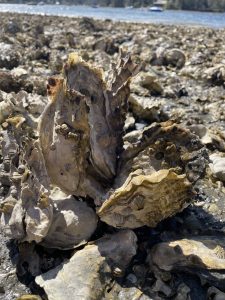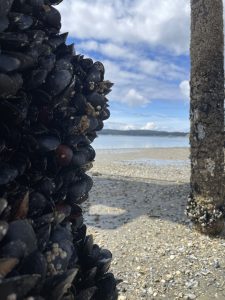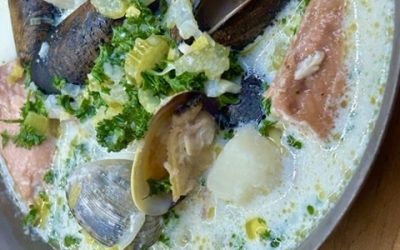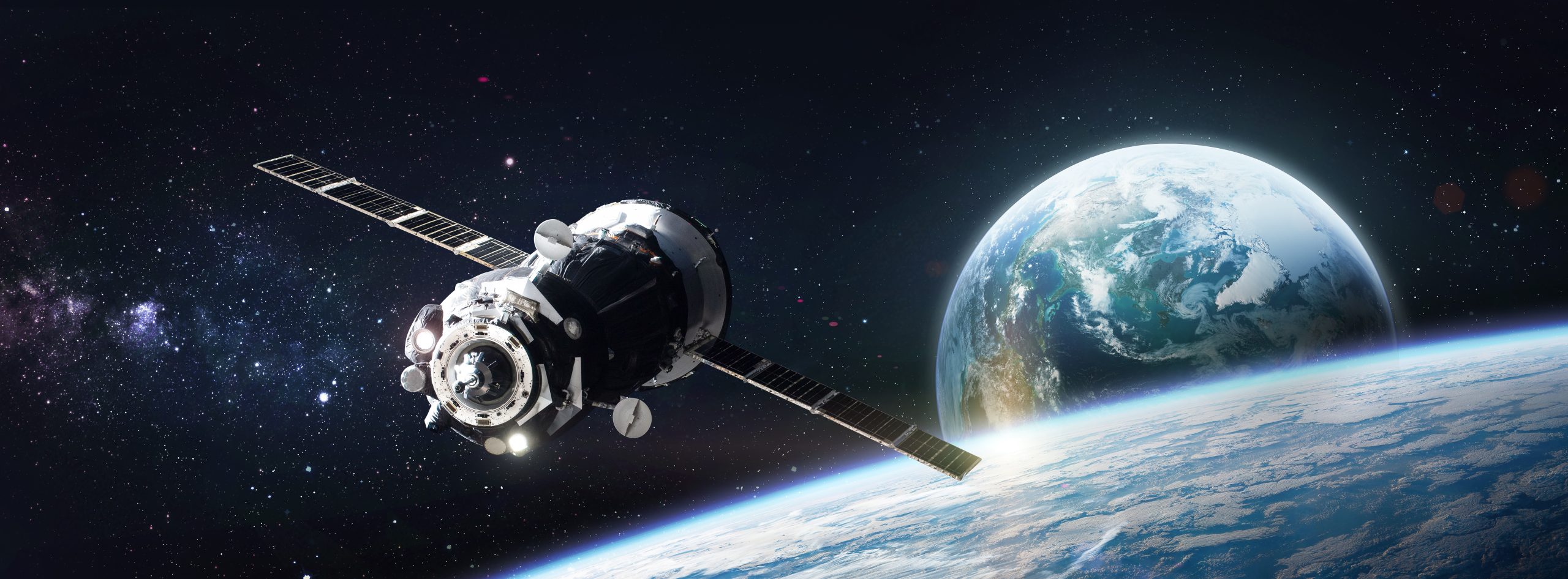By Mark and Lisa Tagal
How Eating Shellfish Helps to Save Our Ocean
In honor of Earth Month, this episode of “In Search of the Perfect Bite” highlights some of the ocean’s Superheros leading the fight against climate change. Aquaculture-raised shellfish is one of the most delicious ways to eat seafood. Much of the shellfish we eat today comes from ocean farms. Oysters, clams, and mussels have been farmed on the Pacific and Atlantic coasts of America for decades, but did you know that shellfish farming is very helpful to our overall marine environment? 
Here are some of the ways aquacultured shellfish are Superheros for climate change in our oceans:
- Aquaculture-raised shellfish create habitats for perch, rockfish, and other shellfish, such as barnacles, by cleaning the water, which helps protect their fragile ecosystems.
- Oyster reefs are an important part of our coastal ecology and help to stabilize sediments, which helps protect the shoreline from erosion and storms.
- Oysters extract carbon ions from seawater to build their shells in a process called calcification. In fact, a single oyster can filter and process up to 50 gallons of water each day, effectively sequestering carbon within their shell structures.
- Another positive side effect of oyster reefs sequestering carbon is it helps protect surrounding habitats like salt marshes from erosion, aiding carbon sequestration in these habitats.
- Individual mussels can filter almost 20 gallons of water per day. A commercial mussel farm like the one located in Penn Cove, Washington, has up to 1,250 mussels on a single line. That means a single line is filtering 25,000 gallons of seawater every day.
- Bivalves have the remarkable potential to provide people with food that is not only environmentally sustainable but also nutrient dense. By being a natural source of protein, shellfish are laden with essential nutrients that could fulfill the dietary needs of nearly 1 billion people in the most vulnerable populations on the planet.
- The environmental footprint of shellfish aquaculture is even lower than many comparable crops in terms of greenhouse gas emissions and land and freshwater use.
- Animal protein production is a significant carbon culprit, from the carbon footprint of feed and fertilizer production to the animals’ methane emissions. This is why a shift in the landscape of environmentally friendly eating decisions needs to be made, and shellfish becoming a larger portion of global diets makes them the superhero of choice.
- Shellfish have a higher protein content than many meats and plant crops and high levels of essential omega-3 fatty acids and micronutrients like iron, zinc, and magnesium. This is especially important in childhood malnutrition, as many of these nutrients are especially crucial to growth. With increased farming opportunities leading to access to consumption, shellfish can actually help communities all around the planet.
- Marine ecosystems get a boost from mussels because they increase biodiversity by acting as ecosystem engineers. Mussels form a habitat for ocean sea creatures to colonize and use, such as barnacles, seaweeds, and nursery grounds for fish.
- Across the world, there is an estimated 579,000 sq. miles of coastline suitable for growing bivalve shellfish. If we could develop even 1% of the coastline, shellfish superheroes could produce enough to fulfill the protein requirements of more than 1 billion people.
 Our world today is feeling the impact of the climate crisis, and shellfish stand out as climate change Superheroes. Their ability to protect coastlines, enhance water quality, create thriving ecosystems, capture carbon dioxide, and provide plentiful protein makes them invaluable allies in our fight against a warming planet.
Our world today is feeling the impact of the climate crisis, and shellfish stand out as climate change Superheroes. Their ability to protect coastlines, enhance water quality, create thriving ecosystems, capture carbon dioxide, and provide plentiful protein makes them invaluable allies in our fight against a warming planet.
Here is one of the easiest recipes with simple ingredients and instructions all the way up to the clean-up work afterward. Another nice part about this dish is that the shells can be recycled when you are done eating. If you live in a coastal area, you can simply take them down to the beach and throw them in the water. If you do not live in a coastal area, they can be crunched up and put into your garden to share calcium for your flowers to grow. Once again, it makes shellfish true superheroes in the battle against climate change.
Shellfish Superhero Stew
- Ingredients:
- 1 pound Manila clams
- 1 pound Penn Cove mussels
- 1 cup of white wine
- 1 cup of chopped parsley
- 1 medium shallot
- 1 bunch of green onions
- ¼ cup olive oil
- 1 stick of butter
- Salt and pepper
- 1-2 tablespoons of crushed garlic
Directions:
- Wash the shellfish and pull the beards off the mussels.
- This dish is very easy to prepare. Heat olive oil in a deep saucepan. Add shellfish. As soon as the shellfish opens, add the rest of the ingredients. The liquor from the shellfish is the base of your stock.
- It’s done as soon as all the mussels and clams are open. Make sure the mussels pull away from the shell a little to confirm they are fully cooked. Pair with a nice hunk of bread.
Enjoy!
References:
National Geographic
BBC
The simple food that fights climate change
By Rachel Lovell





